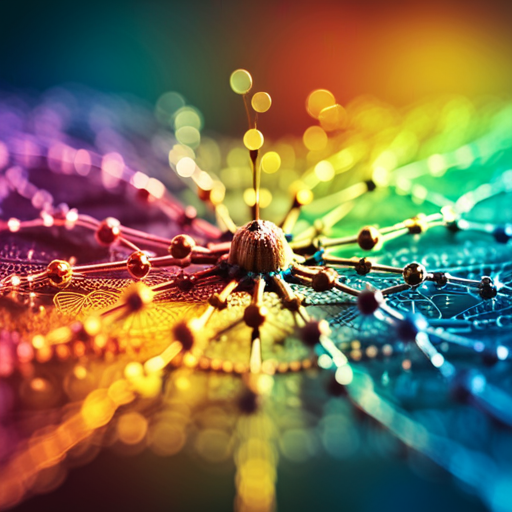Are you curious about how AI creates its incredible artwork?
In this article, we will demystify the inner workings of Generative Adversarial Networks (GANs), the creative engine behind AI’s artistic capabilities.
You’ll learn about the evolution and architecture of GANs, as well as how they are trained to produce unique and creative outputs.
We will also explore the role of adversarial loss and the generator and discriminator networks.
Get ready to dive into the fascinating world of GANs!
Key Takeaways
– GANs consist of a generator and discriminator that work together to create and evaluate data.
– GANs employ deep neural networks, such as CNNs, to generate complex and realistic data.
– Adversarial loss drives the competition between the generator and discriminator, leading to continuous improvement in both networks.
– GANs have a wide range of real-world applications, including art, design, entertainment, and medical research.
The Evolution of Generative Adversarial Networks (GANs)
@ Midjourney AI Image Prompt: /imagine prompt:Create an image showing a timeline-like progression of GAN models through visuals of their architecture, from the inception of GANs to the latest advancements, highlighting notable milestones and improvements in their design, without any accompanying text. –v 5.2 –ar 16:9
The evolution of GANs has led to significant advancements in artificial intelligence. GANs, short for Generative Adversarial Networks, are a type of artificial intelligence model that consists of two neural networks, the generator and the discriminator, which work in tandem to create and evaluate data. The generator’s job is to generate new samples that resemble real data, while the discriminator’s role is to distinguish between real and fake samples. Through a process of competition and collaboration, these networks learn from each other, continually improving their abilities.
The emergence of GANs has had a profound impact on various AI applications. One major area where GANs have made strides is in image generation. By training on large datasets, GANs can generate realistic images that are almost indistinguishable from real ones. This breakthrough has opened up new possibilities in computer graphics, gaming, and even medical imaging.
Moreover, GANs have also revolutionized the field of data augmentation. By generating synthetic data, GANs can expand the size of training datasets, leading to improved model performance and generalization. This has proven particularly useful in domains with limited labeled data, such as healthcare and finance.
Unraveling the Architecture of GANs
@ Midjourney AI Image Prompt: /imagine prompt:Create an image showcasing the intricate layers and connections within a GAN’s architecture, with vibrant colors representing the flow of information. Depict the generator and discriminator networks, illustrating their interconnectedness and the complex feedback loop that drives AI’s creative engine. –v 5.2 –ar 16:9
Explore how GANs’ architecture is unraveled and gain insight into their inner workings.
When delving into the architecture of Generative Adversarial Networks (GANs), you will discover a unique and intriguing framework that allows for the creation of realistic and novel data.
GANs consist of two main components: the generator and the discriminator.
The generator generates synthetic data by transforming random noise into meaningful outputs, while the discriminator evaluates the authenticity of the generated data by distinguishing it from real data.
These two components work in a competitive manner, constantly improving and challenging each other.
The generator aims to create data that is indistinguishable from real data, while the discriminator strives to correctly identify the generated data.
This adversarial process leads to the refinement and enhancement of both the generator and discriminator, resulting in the creation of high-quality and realistic outputs.
By understanding this architecture, you can gain insight into how GANs are able to generate such impressive and creative content.
The intricate interplay between the generator and discriminator is what sets GANs apart and makes them a powerful tool in the field of artificial intelligence.
Training GANs: From Data to Creative Output
@ Midjourney AI Image Prompt: /imagine prompt:Create an image showcasing a progression of datasets transforming into a captivating artwork, symbolizing the journey of training GANs. Starting with raw data, witness the gradual emergence of AI’s creative prowess. –v 5.2 –ar 16:9
When training GANs, you’ll witness the transformation of data into imaginative and unique outputs. It’s an enthralling process that allows you to tap into the hidden potential of your dataset. As you embark on this journey, you’ll see the power of Generative Adversarial Networks (GANs) in action.
First, you’ll feed your GAN with a set of real data, such as images or text, providing it with a rich source of information. The GAN’s generator then takes on the task of creating new samples based on this data. It starts by generating random noise and gradually learns to transform it into meaningful representations.
But the real magic happens when the generator goes head-to-head with the discriminator. The discriminator’s role is to scrutinize the generated samples and distinguish them from the real ones. The generator’s objective is to fool the discriminator into classifying its creations as authentic.
Through a series of iterative steps, the generator becomes more adept at generating outputs that are indistinguishable from real data. This dynamic interplay between the generator and discriminator fosters the emergence of creative and novel outputs.
As you train your GAN, you’ll witness its ability to produce stunning images, compelling texts, or even generate realistic speech. The transformation of data into imaginative and unique outputs is the hallmark of GANs and a testament to the power of artificial intelligence.
Exploring the Role of Adversarial Loss in GANs
@ Midjourney AI Image Prompt: /imagine prompt:Create an image showcasing a vivid representation of a GAN’s creative engine, revealing the dynamic interplay between the generator and discriminator networks through contrasting color patterns and intricate neural connections. –v 5.2 –ar 16:9
To fully grasp the role of adversarial loss in GANs, you must delve into the intricate dance between the generator and discriminator. Adversarial loss plays a crucial role in training GANs by pitting the generator and discriminator against each other in a continuous feedback loop. The generator’s objective is to create realistic outputs that can fool the discriminator, while the discriminator’s goal is to accurately distinguish between real and fake samples.
In this adversarial dance, the generator continually improves its ability to generate realistic outputs by receiving feedback from the discriminator. The discriminator, on the other hand, becomes more adept at distinguishing real from fake samples as it learns from the generator’s output. This iterative process continues until the generator is able to generate outputs that are indistinguishable from real samples, and the discriminator is no longer able to differentiate between them.
To better understand this dynamic, let’s take a look at the following table:
| Generator Loss | Discriminator Loss |
|---|---|
| Decreases as the generator improves | Decreases as the discriminator learns to accurately classify |
| Reflects the quality of the generator’s output | Reflects the effectiveness of the discriminator’s discrimination |
| Measures the divergence between real and generated samples | Measures the ability of the discriminator to distinguish between real and fake samples |
| Drives the generator to create more realistic outputs | Drives the discriminator to become more accurate in its classification |
This table illustrates the intricate relationship between the generator and discriminator, and how their losses are intertwined in the adversarial training process.
Understanding the Generator and Discriminator Networks
@ Midjourney AI Image Prompt: /imagine prompt:Create an image showcasing the architecture of a GAN, with a generator network on one side, depicted as a complex web of interconnected nodes, and a discriminator network on the other side, portrayed as a hierarchical structure with multiple layers. –v 5.2 –ar 16:9
In this discussion, you’ll explore the key points of network architectures and training in the context of GAN dynamics.
You’ll learn about the crucial role these factors play in the functioning of GANs and how they contribute to the generation of creative outputs.
Network Architectures and Training
You can gain a deeper understanding of network architectures and training in GANs by exploring these concepts. By doing so, you’ll be able to unravel the inner workings of this creative engine.
Here are five key points to help demystify this topic:
– Generator and Discriminator: These networks are the core components of a GAN. The generator is responsible for creating new data, while the discriminator determines its authenticity.
– Deep Neural Networks: GANs typically employ deep neural networks to generate complex and realistic data.
– Convolutional Neural Networks: CNNs are often used in GANs to process images and capture spatial relationships effectively.
– Training Process: GANs undergo an adversarial training process where the generator and discriminator continuously learn from each other.
– Loss Functions: Various loss functions, like the binary cross-entropy, are employed to guide the GANs’ training and ensure optimal performance.
Role in GAN Dynamics
Explore the role of GAN dynamics in understanding the interactions between the generator and discriminator networks.
GAN dynamics play a crucial role in the training process of Generative Adversarial Networks (GANs). By understanding these dynamics, you can gain insights into how the generator and discriminator networks interact and learn from each other.
The dynamics refer to the constantly evolving relationship between the two networks. The generator aims to generate realistic data samples, while the discriminator’s goal is to differentiate between real and generated samples.
As the training progresses, the generator learns to generate more realistic samples based on the feedback it receives from the discriminator. Meanwhile, the discriminator improves its ability to distinguish between real and generated samples.
This continuous back-and-forth process between the generator and discriminator leads to the refinement of both networks and the generation of high-quality outputs.
Real-World Applications of GANs: Beyond Art and Design
@ Midjourney AI Image Prompt: /imagine prompt:Create an image showcasing the transformation of a real-life photograph into an AI-generated image, highlighting how GANs can revolutionize industries like healthcare, architecture, and fashion, transcending the boundaries of art and design. –v 5.2 –ar 16:9
In this discussion, we’ll explore the real-world applications of GANs and how they’ve revolutionized various industries.
You’ll discover how GANs are being used in industry advancements, such as creating realistic product prototypes and enhancing manufacturing processes.
Additionally, we’ll delve into the exciting progress made in medical research, where GANs are aiding in the development of treatments and diagnostics.
Lastly, we’ll explore how GANs are being utilized for data synthesis, enabling the generation of large datasets for training machine learning models.
Industry Advancements Using Gans
Industry advancements using GANs have revolutionized the fields of art, design, and entertainment. These advancements have sparked a wave of innovation and opened up new possibilities for creators and consumers alike.
Here are some key breakthroughs that have reshaped the industry:
– Enhanced visual effects in movies and gaming, creating hyper-realistic and immersive experiences.
– AI-powered fashion design, enabling designers to generate unique and cutting-edge designs effortlessly.
– Synthetic voice and music creation, allowing artists to compose new songs or mimic the voices of iconic personalities.
– Virtual reality experiences, where GANs generate realistic environments and characters, blurring the lines between real and digital worlds.
With GANs at the forefront of these advancements, the industry is witnessing a transformation in how art, design, and entertainment are created and consumed. The potential of GANs seems limitless, and we can expect even more exciting developments in the future.
Gans in Medical Research
The use of GANs in medical research is revolutionizing the field and has the potential to transform the way we diagnose and treat diseases.
With GANs, you can generate realistic medical images, such as CT scans and MRIs, that can aid in early detection and accurate diagnosis. These AI-powered models can learn from vast amounts of data, allowing them to identify patterns and anomalies that might go unnoticed by human experts.
GANs can also be used to simulate the effects of different treatments, helping doctors and researchers make informed decisions about the most effective course of action.
Furthermore, GANs enable the creation of personalized medicine by generating patient-specific models that predict disease progression and response to treatment.
In short, GANs are opening up new avenues in medical research, offering the potential to revolutionize healthcare as we know it.
Gans for Data Synthesis
To synthesize data using GANs, you can generate realistic datasets that mimic real-world scenarios, allowing you to train AI models more effectively. By utilizing GANs for data synthesis, you have the ability to create diverse and representative datasets that capture the complexity and variability of real-world data.
GANs, or Generative Adversarial Networks, consist of two components: the generator and the discriminator. The generator generates synthetic data, while the discriminator evaluates the authenticity of the generated data. Through an iterative process, the generator and discriminator work together to improve the quality of the generated data, making it indistinguishable from real data.
This synthetic data can be used to augment existing datasets and address data scarcity issues, enabling more robust and accurate training of AI models in various domains.
Frequently Asked Questions
How Can Gans Be Used in Fields Other Than Art and Design?
In fields other than art and design, GANs can be utilized in various ways. They can be used in medicine for generating synthetic data, in finance for fraud detection, and in gaming for creating realistic virtual worlds.
What Are the Key Challenges in Training Gans and How Can They Be Overcome?
The key challenges in training GANs are instability and mode collapse, but you can overcome them by using techniques like mini-batch discrimination and label smoothing.
Can Gans Generate Realistic and Coherent Text or Only Visual Content?
Yes, GANs can generate realistic and coherent text in addition to visual content. They use a two-step process involving a generator and discriminator to produce high-quality text that is indistinguishable from human-generated text.
What Is the Role of the Discriminator Network in the GAN Architecture?
The discriminator network plays a crucial role in the GAN architecture. It’s responsible for distinguishing between real and fake data, providing feedback to the generator network, and helping improve the overall quality of generated content.
Are There Any Ethical Concerns or Potential Risks Associated With the Use of Gans in Real-World Applications?
There can be ethical concerns and potential risks when using GANs in real-world applications. These include issues like the generation of deepfake content and the potential for misuse in areas like fraud or deception.
Conclusion
So now you have a better understanding of how Generative Adversarial Networks (GANs) work. From their evolution to their architecture, training process, and the role of adversarial loss, GANs are truly fascinating.
The generator and discriminator networks play a crucial role in creating realistic and creative outputs.
GANs are not limited to just art and design, they have real-world applications in various fields.
Keep exploring the potential of GANs and see how they can revolutionize industries and creativity.



